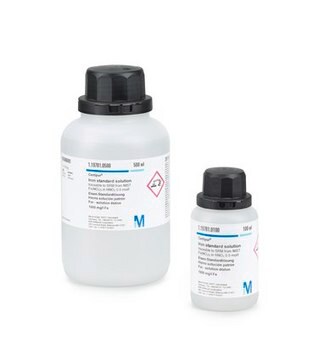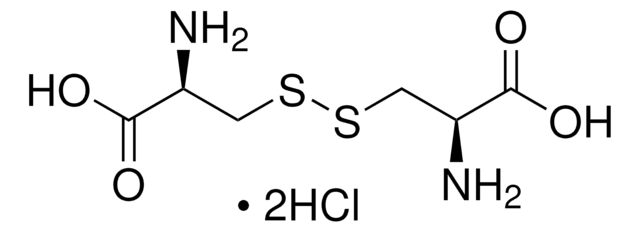A7094
L-asparagina
≥98.0%, suitable for cell culture, BioReagent, non-animal source
Sinonimo/i:
4-ammide dell’acido (S)-2-aminosuccinico, 4-ammide dell’acido L-aspartatico, Acido (S)-(+)-2-aminosuccinamico
About This Item
Prodotti consigliati
Nome del prodotto
L-asparagina, from non-animal source, BioReagent, suitable for cell culture, ≥98.0%
Origine biologica
non-animal source
Nome Commerciale
BioReagent
Saggio
≥98.0%
Stato
powder
Attività ottica
[α]20/D 33.0 to 36.3 °, c = 10 in 6 M HCl
tecniche
cell culture | mammalian: suitable
Impurezze
endotoxin, tested
Colore
white
Punto di fusione
233-235 °C (lit.)
Solubilità
H2O: 20 mg/mL
Cationi in tracce
Fe: ≤10 ppm
heavy metals (as Pb): ≤10 ppm
<0.1% (Ammonia (NH3))
Gruppo funzionale
amide
amine
carboxylic acid
Temperatura di conservazione
room temp
Stringa SMILE
[H]O[H].N[C@@H](CC(N)=O)C(O)=O
InChI
1S/C4H8N2O3.H2O/c5-2(4(8)9)1-3(6)7;/h2H,1,5H2,(H2,6,7)(H,8,9);1H2/t2-;/m0./s1
RBMGJIZCEWRQES-DKWTVANSSA-N
Cerchi prodotti simili? Visita Guida al confronto tra prodotti
Categorie correlate
Descrizione generale
Applicazioni
Azioni biochim/fisiol
Caratteristiche e vantaggi
- Adeguato per la ricerca in biochimica e biologia cellulare
- Composto qualità elevata che trova impiego in molteplici applicazioni di ricerca
Altre note
Prodotti correlati
Codice della classe di stoccaggio
11 - Combustible Solids
Classe di pericolosità dell'acqua (WGK)
WGK 1
Punto d’infiammabilità (°F)
Not applicable
Punto d’infiammabilità (°C)
Not applicable
Dispositivi di protezione individuale
Eyeshields, Gloves, type N95 (US)
Scegli una delle versioni più recenti:
Certificati d'analisi (COA)
Non trovi la versione di tuo interesse?
Se hai bisogno di una versione specifica, puoi cercare il certificato tramite il numero di lotto.
Possiedi già questo prodotto?
I documenti relativi ai prodotti acquistati recentemente sono disponibili nell’Archivio dei documenti.
I clienti hanno visto anche
Il team dei nostri ricercatori vanta grande esperienza in tutte le aree della ricerca quali Life Science, scienza dei materiali, sintesi chimica, cromatografia, discipline analitiche, ecc..
Contatta l'Assistenza Tecnica.













